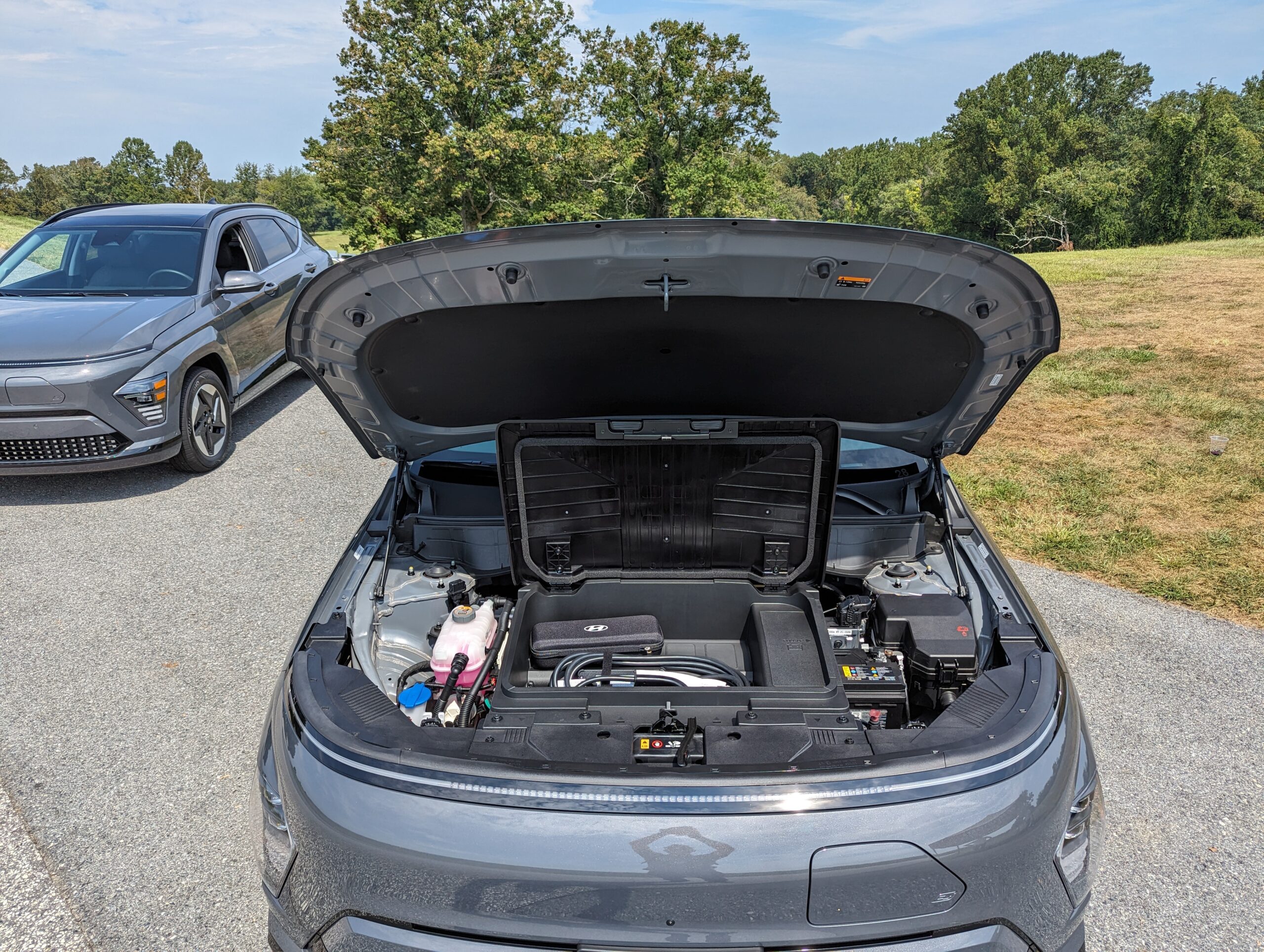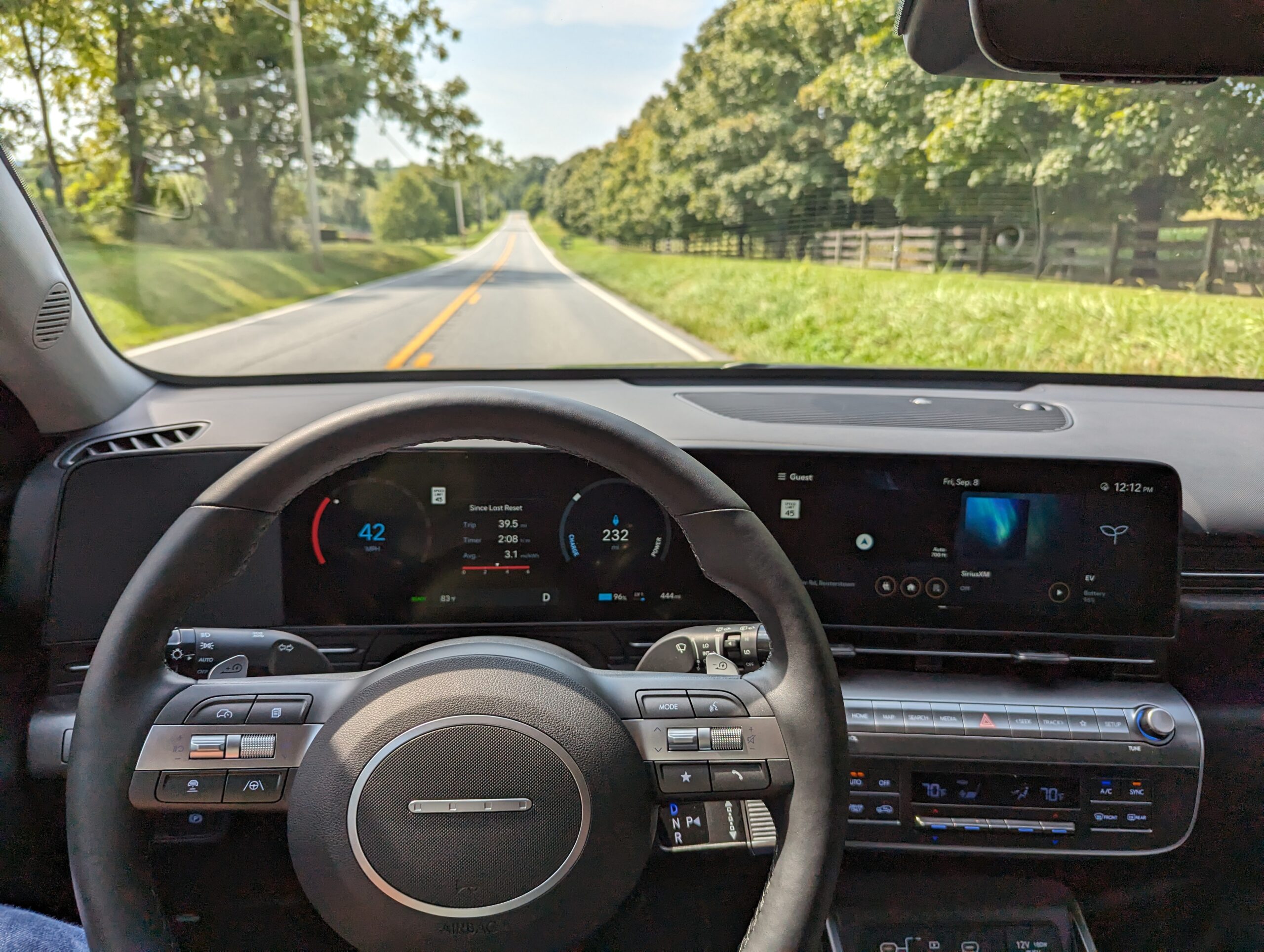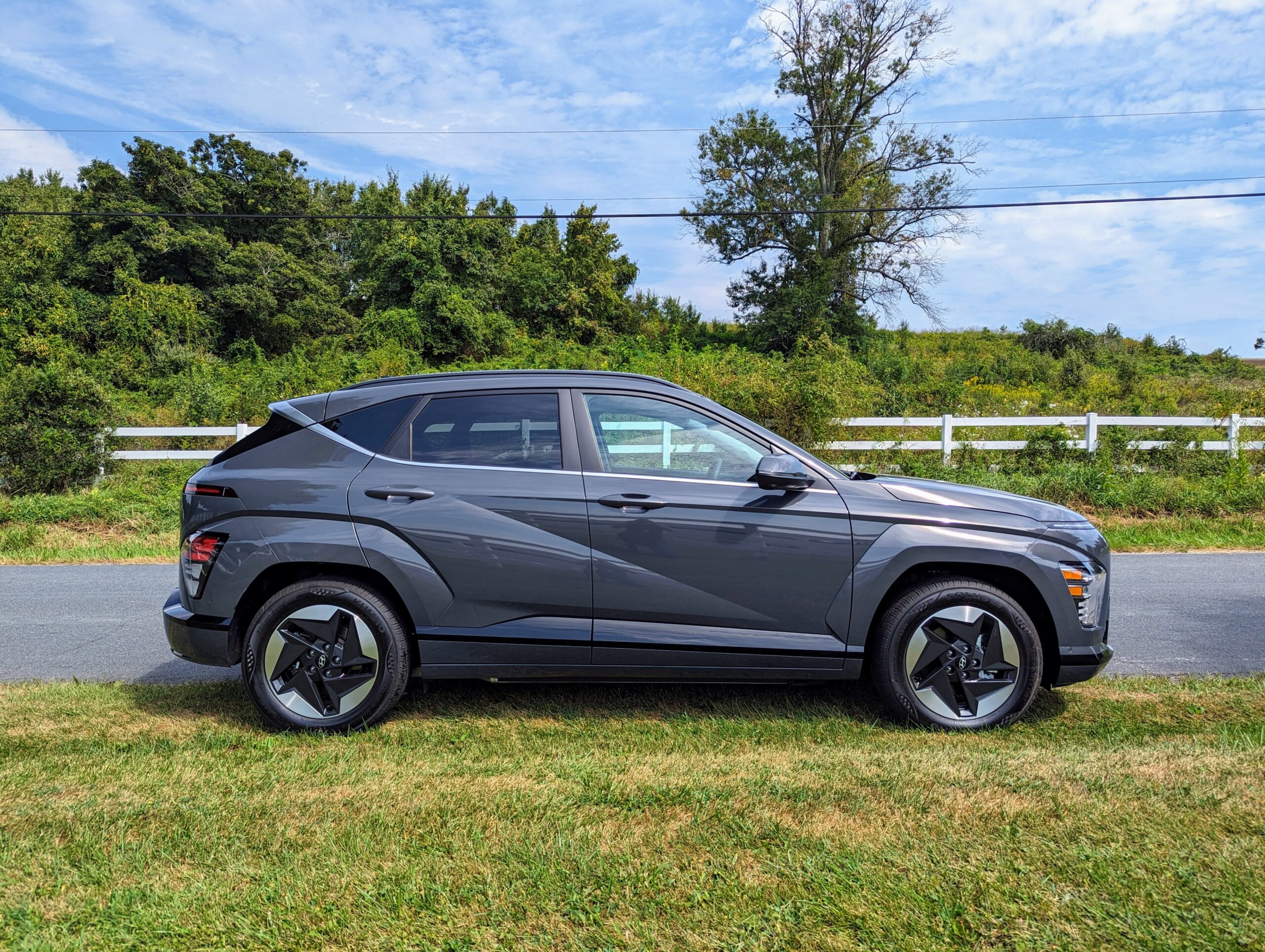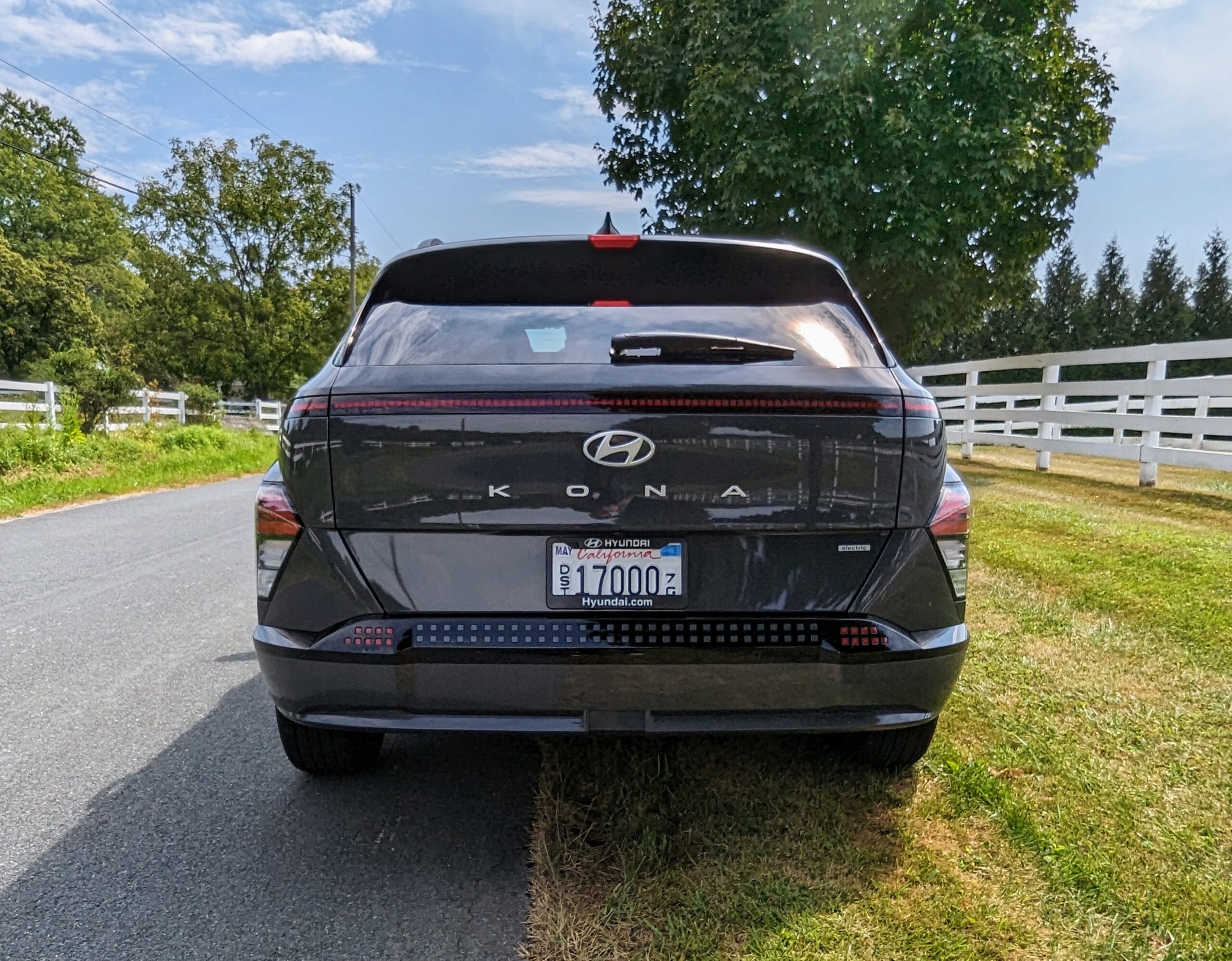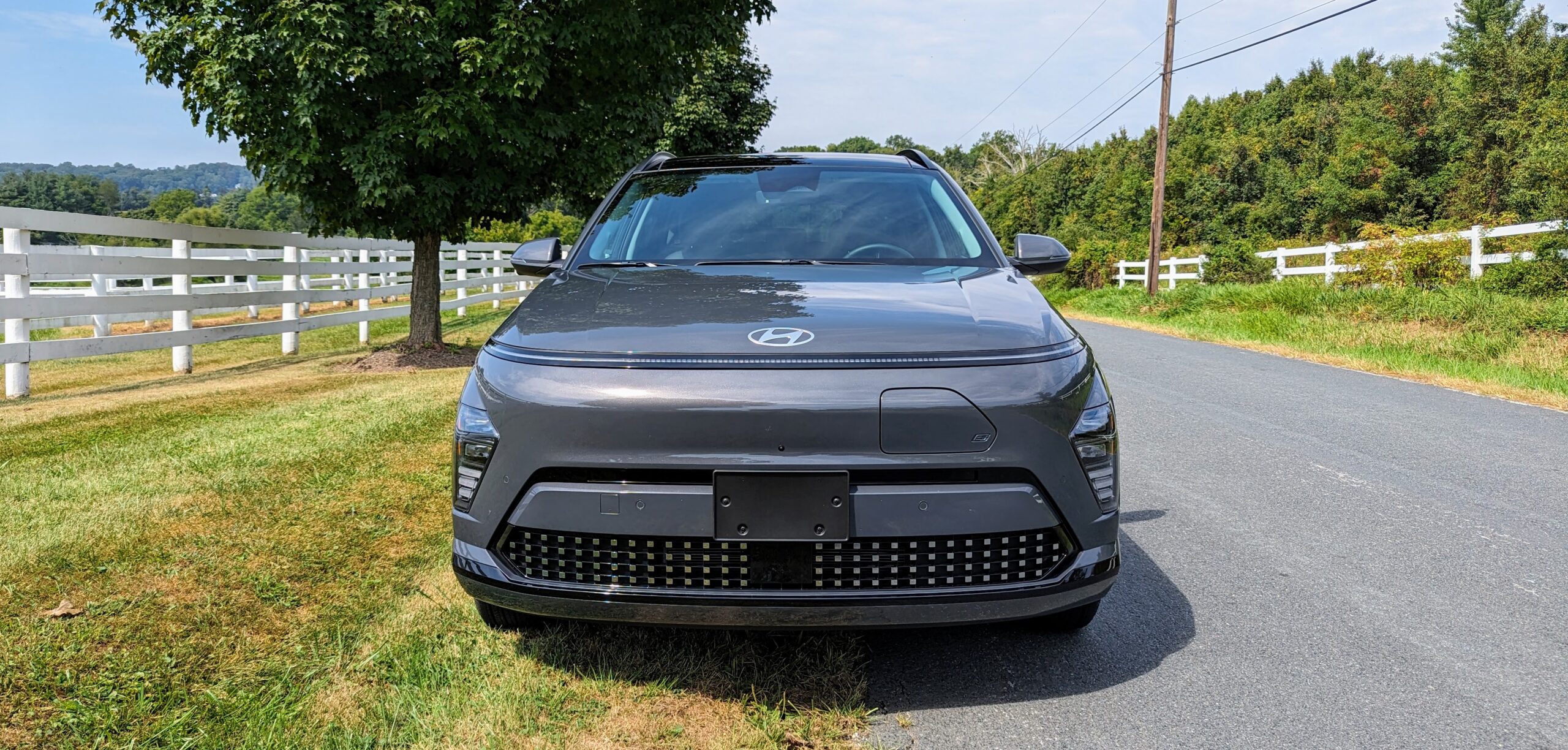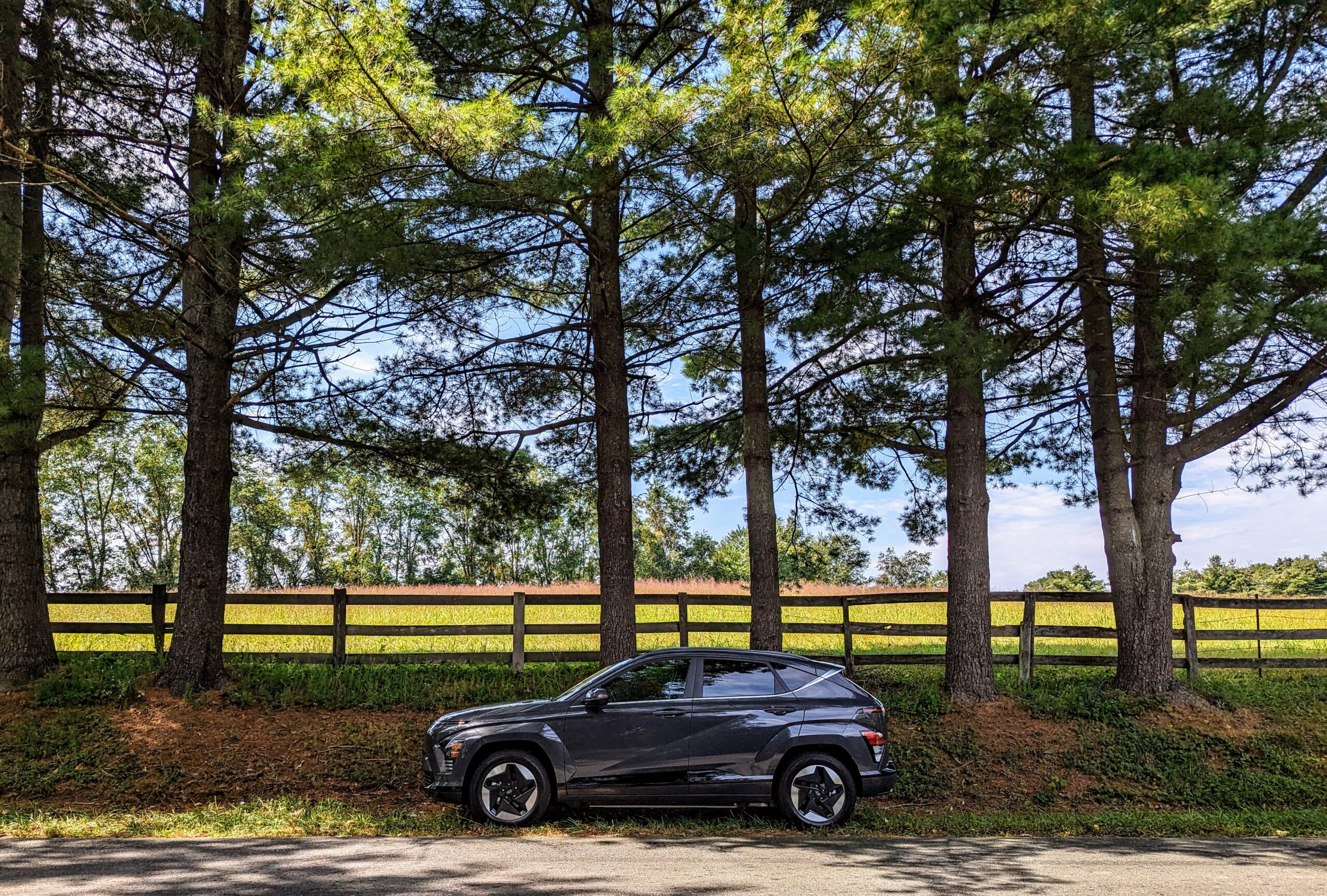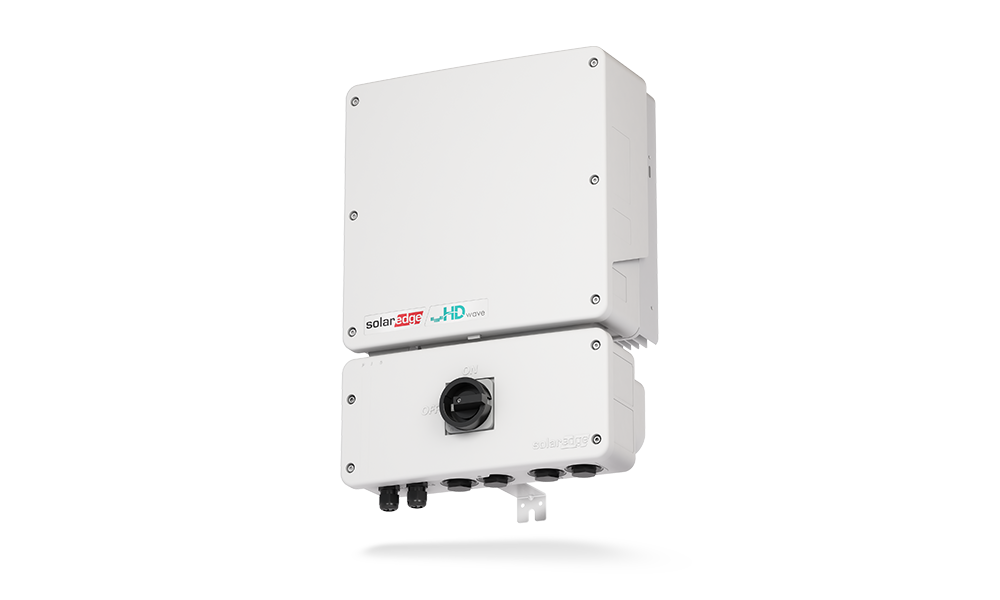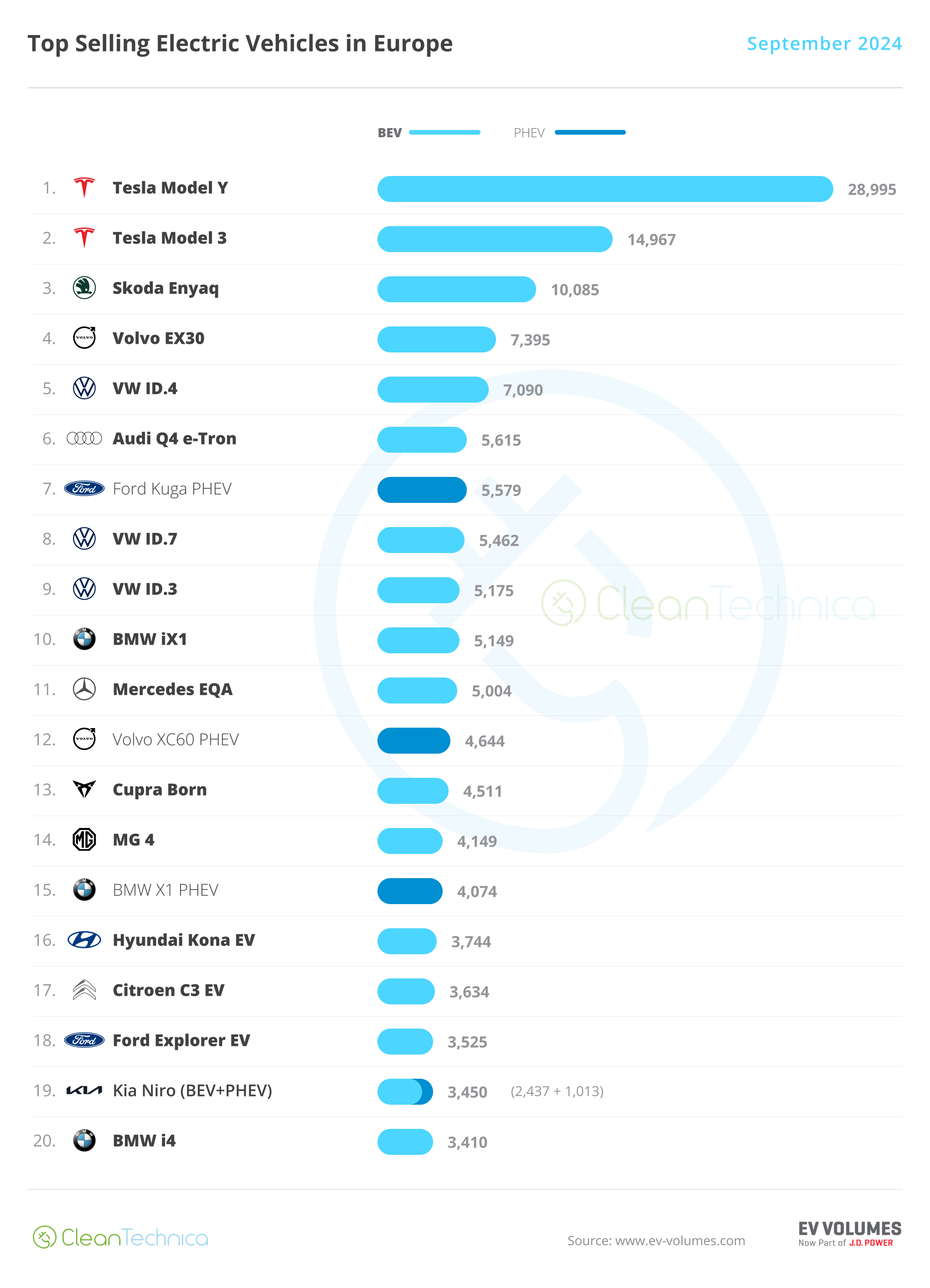Sign up for daily news updates from CleanTechnica on email. Or follow us on Google News!
Hyundai gave its popular Kona a facelift for 2024, and we were some of the first people outside the company to take one of the fully electric prototypes for a spin. We typically drive early production builds, so they still might tweak a few things before its locked in for production later this year, but the major features are likely locked in at this point.
Design
Hyundai brought us out to countryside surrounding Baltimore, Maryland, to wheel around on the company’s new popular CUV. The new 2024 Kona EV comes in a new refined package with a slightly longer wheelbase and different exterior look than its predecessor. This move is right in line with what other cars in the segment are doing and keeps the Kona competitive in its segment.
The exterior features bold new “horizon lamps” LED light bars across the front and rear of the car. These give the cars what is almost a futuristic stormtrooper vibe. It truly is a striking feature and I couldn’t help but take notice of Hyundai’s vans sporting the horizon lamp accent on a visit to Seoul earlier this year.
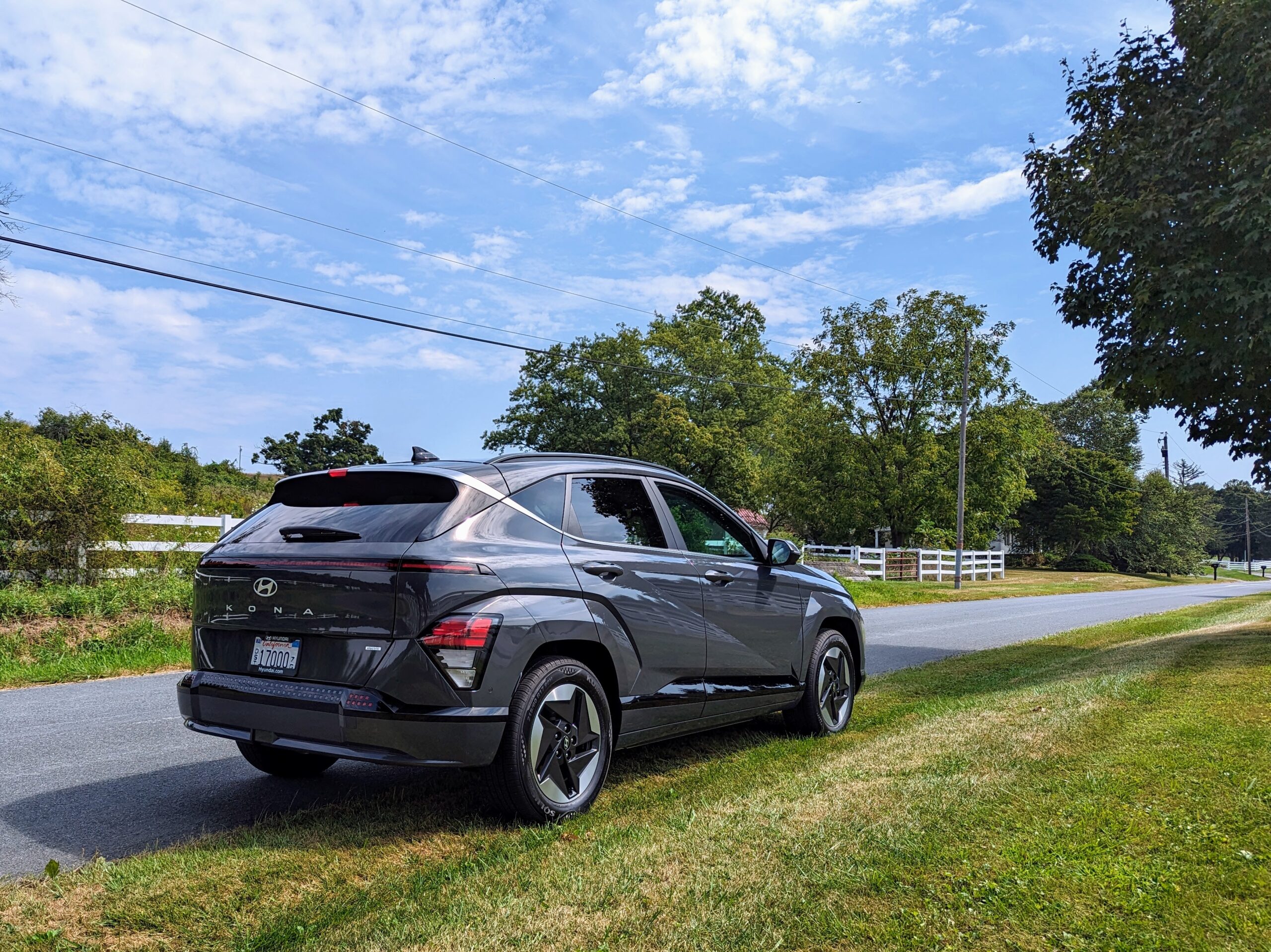
A bold light bar across the rear is flanked by a foundation of Hyundai’s signature pixelated LEDs. Image credit: Kyle Field, CleanTechnica
Underneath the horizon lamp on the front and rear of the car, the Kona EV sports Hyundai’s pixelated horizon lamp as almost a shadow of the bold line that sits higher up on the vehicle. It’s a sophisticated combination that gives the Kona a bit more subtlety than its edgier sibling, the IONIQ 5.
Paired with its wide body style fender flares, the new Kona EV feels edgier and more futuristic than its predecessor. The fender flares come in both a more subdued, painted trim and a contrasting grey kit which we’re eager to see in person.

The large rear hatch area has a secret sub trunk compartment where you can hide your valuables. Image credit: Kyle Field, CleanTechnica
Popping the hood of the new 2024 Kona EV reveals what looks like the plastic cover on many combustion engines but is actually the sealed cover for a small front storage area. By default, a 110 volt wall charger for the car lives there. Our preview unit also had an adapter for the J1772 to AC plug in it. The sticker on the unit said it would support AC power output at up to 15 amps at 125 volts.
This is a neat little gem that we were told Hyundai plans to sell as an accessory and is just one more of the small benefits of building cars to support vehicle-to-grid. More important than a single AC outlet in a pinch, these vehicles will likely support vehicle-to-X, meaning it will push power out to whatever your life demands, whether it be your house, your camping setup, your laptop in a pinch, or something else.

Hyundai’s J1772 to NEMA 5-15 AC outlet adapter is a useful add on. Image credit: Kyle Field, CleanTechnica
Stepping inside the 2024 Kona EV, the interior felt spacious and relaxed. This was done by optimizing the interior space with humans at the center of the design, adding more volume to the interior, and by adding noise dampening. Hyundai reduced the thickness of the front seats by 30% and added a noticeable curve to the back of the seat, giving rear passengers more leg room with no compromise up front.
They also opened up space in the center console by moving the shifter up to the steering column. The new stalk shifter however, is not as intuitive, as its not operated by pushing it up or down physically, but by twisting the end knob as if adjusting a windshield wiper or similar function in a traditional car.
It is a blocky rectangular mechanism and takes a little bit of getting used to, but is something I’m sure owners will have no problem getting used to after a few drives. Having said that, expect this to be a one of the things that people need to be taught when driving this car for the first time, which feels like an step backwards away from an intuitive user experience.
Up front, the new twin 12.3-inch high definition displays are gorgeous and the improved processors and hardware powering them has made them responsive and easy to use. On the software side of things, however, the UI still retains some of the clunkiness associated with legacy automotive OEM software installations in the infotainment space.
We were trained to use touchscreens by our smartphones and while they’re getting better and better with every revision, Hyundai’s in-car system still isn’t as intuitive as it could be or should be. For example, finding saved points of interest on the map required a bit of a helping hand to find. Getting familiar with the ins and outs of the system will happen over time, but owners will have to invest some time to get used to, rather than having it be an intuitive experience from day one.
The trade-off is minimal, because once you do get used to it, the gauge cluster style display behind the steering wheel and the infotainment style display if the center of the vehicle are both beautiful and easy to use.
Hyundai’s Head of Interior Design Kevin Kang said at the event that Hyundai aspired to strike a better balance between the physical and the digital worlds than some EV manufacturers who seem reluctant to put buttons in their vehicles. Hyundai approached this with intention, putting in enough buttons to get the job done for critical tasks, but with an equal amount of power in non-critical areas on the touchscreens.
This philosophy plays out in the car with the climate control being easy to read and adjust from the physical climate dashboard located in the center console just below the center display. It is augmented with a handful of buttons just above it for the infotainment system, which serve as shortcuts for the digital display.
Below the climate controls lives a large drive mode selection dial. It’s an odd addition, as most users likely won’t use this after the first week. On either side of the drive mode dial are seat heater selection buttons, which are a nice touch, as these are things many drivers will use on a regular basis and something you also want the passenger to be able to control independently without having to ask for permission to use the center display or to train them on its use. The seats are also ventilated and the controls for that live below the seat heater buttons.
In between, all of those are the heated steering wheel option, which is surely something that’s helpful to have on a quick button in colder climbs, while the auto hold parking camera and parking distance buttons don’t necessarily fall into that category. The parking option specifically, if you like things that should just automatically come up on the display when the car detects parking lines or moves into auto park mode.
While the battle between the fully digital world and the fully physical world with buttons continues, it still feels like Hyundai has room to trim out a bit of the fat in the physical button world with what feels like dozens of buttons and controls to learn in the car on the steering wheel and beyond.
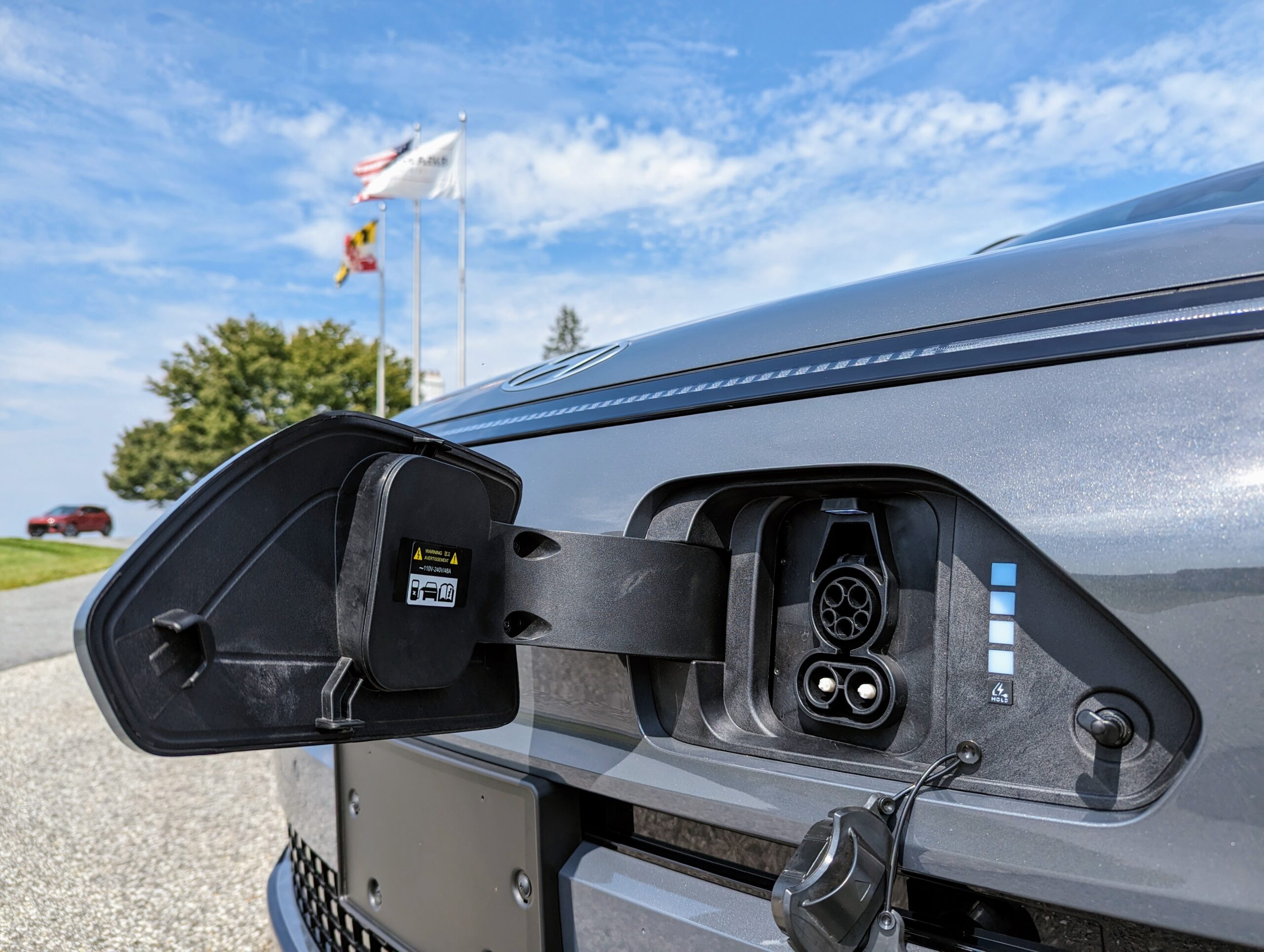
The front location of the EV charging port is a sensible choice. Image credit: Kyle Field, CleanTechnica
Overhead, a moonroof lives dormant behind a fabric style cover. The combination provides the extra headroom provided by moving to a full glass roof with the completely shaded driving experience of a traditional roof when it’s not needed. When the sun does come out, however, it’s a simple touch of a button to open both the cloth covering and the window itself for a bit of extra fresh air and some time in the sun.
Driving
Having driven the internal combustion version of the 2024 Hyundai Kona earlier in the day, switching into the EV was like floating in a dream. The new 2024 Kona EV does come with a bit of extra noise dampening and while it is noticeable in the combustion build, it makes the EV feels like a luxury car in comparison.
The powertrain makes no perceivable noise, with the only exterior noise coming from the tires, which comes in through the wheel wells when slowing, accelerating quickly, or taking hard turns.
Inside the Kona EV, you’ve got the option of four driving modes, choosing between eco, normal, sport, and snow. We switched between them all and found very little to differentiate between them. In all modes, the acceleration is enough to push your head back but there is also a noticeable lag in the pedal response across the board.
Hyundai’s team mentioned they had been working to optimize the balance of power output in the car for its size, even reducing the overall torque numbers on the new motor compared to the previous year. We asked Hyundai about this and they shared that balancing the torque output with the pedal action is a bit of a challenge. It definitely feels like there’s an opportunity to strike a more performance oriented balance, especially when you kick it into the Sport driving mode.
Flying through the curvy country roads, the battery gives the car a solid feel and helps all four wheels stay planted on the ground, with less side-to-side body roll than you would expect from an internal combustion SUV. Body sway from front to back feels like it could still use some tuning, with rapid acceleration causing a noticeable lift in the nose. Rapid braking similarly causes the nose to dip more than we would expect in a battery-electric vehicle.
That isn’t to say the Kona EV isn’t fun to drive, because it definitely is. Its low profile holds fast to the road thanks to the battery, with its electric motor kicking in with enough power and torque to keep your pulse pounding. It was a blast ripping around the country roads outside Baltimore in the Kona EV, and we can’t wait to see what they do in the fully polished production version later this year.
Slamming the brakes after rapid straight line acceleration and on corners was robust, and they kicked in with an extra bit of fervor to provide all the stopping power we needed. It’s a compact car with tons of functionality.
Overall
The new model year 2024 Kona EV brings with it a number of welcome upgrades, including extra interior space, improved displays, less cabin noise, and a more appropriately tuned motor. These make the Kona EV one of the best values in the space and give potential owners numerous tangible reasons to opt for it instead of the competition
Combined with an already impressive set of features at a very reasonable price point, we can’t wait to see what the 2024 Kona EV looks like in its full production getup.
Disclaimer: Hyundai paid for the author’s travel and accommodations to attend this driving event.
Have a tip for CleanTechnica? Want to advertise? Want to suggest a guest for our CleanTech Talk podcast? Contact us here.
EV Obsession Daily!
I don’t like paywalls. You don’t like paywalls. Who likes paywalls? Here at CleanTechnica, we implemented a limited paywall for a while, but it always felt wrong — and it was always tough to decide what we should put behind there. In theory, your most exclusive and best content goes behind a paywall. But then fewer people read it!! So, we’ve decided to completely nix paywalls here at CleanTechnica. But…
Thank you!
Tesla Sales in 2023, 2024, and 2030
CleanTechnica uses affiliate links. See our policy here.

